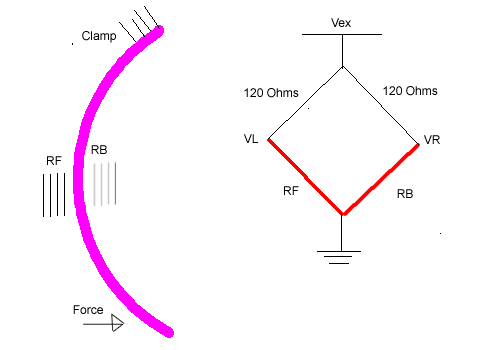EN123 Strain Gauge Take Home Honor System Quiz 2002
Study the strain gauge placements given below and calculate an answer to
the question asked.
Find half an hour to write out your answer to this quiz, sometime before Monday
Nov 4 at 10.m.
You are not allowed to collaborate with your teammates, or any other any other
human, for that matter.
However, you can utilize any notes you like.
You can log onto the internet, if you think that will help you.
For example, you may want to refer to equations in the Strain Gauge Lecture
Notes
of the EN123 Archive Website.
name________________________________ answer:
Gain =____________________
Consider a rectanguloid bar of rigid material, 0.24 cm thick, 4 cm wide and
100 cm long.
The bar is clamped at one end, like a cantilever beam, and bent so that the
"front" of the
bar is curved out and the the "back" of the bar is curved in (compressed).
There is a longitudinal strain gauge on the front face (RF) of the bar (the
wide part),
and on the back of the bar is another longitudinal gauge (RB).
The gauges are 120 Ohms, unloaded.
When the bar is curved as shown, the front gauge and the back gauge have
equal magnitude and opposite sign of strain.
The two strain gauges find their way into a Wheatstone bridge, as diagrammed
below.
The other resistors in the bridge are also 120 Ohms.

An instrumentation amplifier is across the bridge,
where its Vout = Gain * (VL - VR) volts. Vex is 12 volts.
If there is no load on the bar, Vout is zero volts.
Poisson's ratio of the strain gauge material is 0.5,
but the material of the bar has a lower Poisson's ratio, of 0.30.
Due to the force (torque) shown, the strain on the front strain gauge is +.003.
Your question:
If Vout = 3.6 volts, what is the gain of the differential amplifier?
Be sure to take account of both strain gauges when computing your answer...
Your quiz will be graded by the next class meeting.
If you figure out the correct answer, your scorecard will be signed;
if not, wait for further instructions...
A gain value within plus or minus 5% of the exact answer will be counted
as correct.
In case you did everything right expect for a calculation mistake show your
work on this test page.
